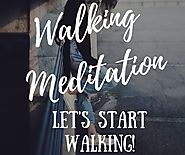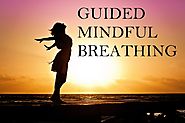-
About
- About Listly
- Community & Support
- Howto
- Chrome Extension
- Bookmarklet
- WordPress Plugin
- Listly Premium
- Privacy
- Terms
- DMCA Copyright
- © 2010-2025 Boomy Labs


Listly by denizyalm
Walking meditation is a wonderful complement to your seated meditation practice. For some people, it is actually an introduction for it, since it is easier to start with.
The most common meditation posture after sitting is walking. In meditation centers and monasteries, indoor halls and outdoor paths are often built for walking meditation. On meditation retreats, regular walking meditation is an integral part of the schedule.
Walking meditation is a form of meditation in action. In walking meditation we use the experience of walking as our focus. Unlike seated meditation, when walking your eyes are open, body is standing and moving, and there is a bit more interaction with the outside world. Because the body is moving, it is easier to be mindful of the body sensations and anchored in the present moment; for this reason, many people find walking meditation easier than seated meditation.
Here are some things to keep in mind, regardless of the “type” of walking meditation you choose.
Place. It may feel a bit awkward in the beginning, so you might consider doing walking meditation first in your backyard. If you are walking outside, find a secluded place where you won’t be distracted or disturbed. Ideally, the walking path should be slightly enclosed, so there is less distraction from the scenery, and the mind can more easily go inwards. Stay away from high-traffic and heavily populated walking areas. It’s also important that you feel safe in your surroundings.
Length. Ideally practice for at least 15 minutes. Since there is no discomfort of seated practice or of not moving, you can naturally do it for longer periods than seated meditation.
Pace. Slow is better. Pace should be steady and even. If your mind is agitated, or your ability to focus is weak, walk very slowly, until you can stay in the present moment with each step.
Anchoring. Before you start your walking session, spend a minute or two just standing there, breathing deeply and anchoring your attention in your body.
Stand with your feet hip-width apart and balance your weight evenly on both feet. Take the time to feel the stability of the ground beneath you.
Take a few deep breaths.
Close your eyes and do a scan of your whole body, starting at your feet. Make note of any sensations, thoughts or feelings and take the time to explore the sensations fully.
Bring your awareness to your body, noticing how your body feels as you are standing, and becoming aware of all the sensations going on in your body.
Technique. Choose one of the six techniques explained in this post. If you don’t know which to try, read my recommendation at the end of this article.
Re-focusing. Just as in seated meditation, whenever your mind starts to engage with thoughts (or any type of mental content), bring your attention back to your walking and your breathing.
Attitude. We are not going anywhere. There is nothing to achieve, except mastering our attention and presence. Simply be with the process.
The ability of focusing, developed in walking meditation, is easily carried into our daily life. And also into seated practice, when there are actually less sensory stimuli. It’s a powerful tool at your disposal.
For those that do long sessions of seated practice, walking meditation can be helpful to overcome the torpor and lethargy that unavoidably comes. And also offer a chance for the body to replenish.
“When we are tired or sluggish, walking can be invigorating. The sensations of walking can be more compelling than the more subtle sensations of breathing while sitting. Walking can be quite helpful after a meal, upon waking from sleep, or after a long period of sitting meditation. At times of strong emotions or stress, walking meditation may be more relaxing than sitting. An added benefit is that, when done for extended times, walking meditation can build strength and stamina.” (Gil Fronsdal)
The activity of walking, in itself, brings several health and well-being benefits.
To practice, select a quiet place where you can walk comfortably back and forth, indoors or out, about ten to thirty paces in length. Begin by standing at one end of this “walking path,” with your feet firmly planted on the ground. Let your hands rest easily, wherever they are comfortable. Open your senses to see and feel the whole surroundings. After a minute, bring your attention back to focus on the body. Center yourself, and feel how your body is standing on the earth. Feel the pressure on the bottoms of your feet and the other natural sensations of standing. Let yourself be present and alert.
Begin to walk a bit more slowly than usual. Let yourself walk with a sense of ease and dignity. Relax and let your walking be easy and natural, as if you were a king or queen out for a royal stroll. Pay attention to your body. With each step feel the sensations of lifting your foot and leg off of the earth. Then mindfully place your foot back down. Feel each step mindfully as you walk. When you reach the end of your path, pause for a moment. Center yourself, carefully turn around, pause again so that you can be aware of the first step as you walk back. You can experiment with the speed, walking at whatever pace keeps you most present.
Continue to walk back and forth for ten or twenty minutes or longer. As with the breath in sitting, your attention will wander away many times. As soon as you notice this, acknowledge where it went softly, “wandering,” “thinking,” “hearing,” “planning.” Then return to feel the next step. Like training a puppy, you will need to come back a thousand times. Whether you have been away for one second or for ten minutes, no matter. Simply acknowledge where you have been and then come back to being alive here and now with the next step you take.
Use the walking meditation to calm and collect yourself and to live more wakefully in your body. Practice at home first. You can then extend your mindful walking in an informal way when you go shopping, whenever you walk down the street or walk to or from your car. You can learn to enjoy walking for its own sake instead of the usual planning and thinking and, in this simple way, begin to be truly present, to bring your body, heart and mind together as your move through your life.
This meditation is taken from the book, “The Wise Heart“
1.
Stand up STRAIGHT with your back upright but not stiff. Feel your feet touching the ground and let your weight distribute evenly.
2.
Curl the THUMB of your left hand in and wrap your fingers around it. Place it just above your belly button. Wrap your right hand around it, resting your right thumb in the crevice formed between your left thumb and index finger. (This creates some balance for you and keeps your swinging arms from being a distraction.)
3.
Drop your GAZE slightly. This helps you maintain focus.
4.
Step out with your left FOOT. Feel it swing, feel the heel hit the ground, now the ball, now the toes.
5.
FEEL the same as the right foot comes forward.
6.
Walk at a STEADY pace, slightly slower than in daily life but not funereal. When your attention wanders, bring it back to the sensations of your feet touching the ground.
Try to wear comfortable clothing and shoes, if possible. Begin by standing still and becoming aware of your body and how it feels. Notice your posture, feel the weight of your body pressing down toward the ground, and your heels pushing into your shoes; become aware of all the subtle movements that are keeping you balanced and upright.
Allow your knees to bend very slightly and feel your hips as your center of gravity. Take a few deep belly breaths and bring your awareness into the present moment.
Now begin to walk slightly slower than normal pace, maintaining an almost imperceptible bend in the knees. With each step, be aware of the gentle heel-to-toe rhythm as each foot makes contact with the ground.
Breathe naturally and fully, deeply filling your lungs with each inhalation, but being careful not to strain or struggle in any way. Allow your eyes to focus softly ahead of you, taking in as much of the periphery as comfortable. Try to maintain a soft body and breathing awareness as you walk naturally and easily.
When your attention drifts away from the sensations of walking and breathing, take notice of those thoughts, moods, or emotions without judgment and gently guide your awareness back to the present moment, back to the walking.
Continue this mindful walking for anywhere from 5 to 20 minutes or longer if comfortable.
When it’s time to end the meditation, allow yourself to come to a gentle halt. Pause—once again experiencing yourself standing still—as you feel the earth beneath your feet. Take a few deep breaths as this session comes to close. Slowly return to your regular activity.
Hopefully the benefits will whet your appetite for mindful walking.

Let discover walking meditation benefits and secret

Here's a mindful present for you - download this mindful walking meditation here :) http://mindfulwalking.mindspace.org.uk More information on Mindful Walkin...

30 Day To Improve Quality of Live: http://bayart.org/ Peace Starter Meditation (free): https://play.google.com/store/apps/details?id=com.persona.peacestarter...